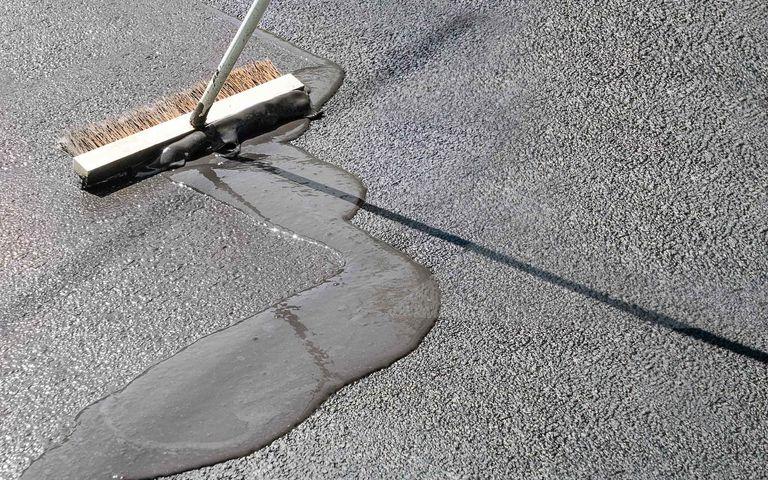Serving Central Florida and the Tampa Bay Region

Another Job Wells Done!
813-519-4382
Blog

Asphalt Challenges Unique to the Tampa Bay Area: From Clearwater to Lakeland
The Tampa Bay region's distinctive climate and environmental conditions create specific challenges for asphalt surfaces that property owners from Clearwater to Lakeland encounter year-round. The unique combination of subtropical weather, coastal influences, and Florida's intense development pressures requires specialized knowledge for maintaining driveways, parking lots, and commercial surfaces in this dynamic metropolitan area.
Subtropical Climate Extremes
The Tampa Bay area experiences some of Florida's most challenging conditions for asphalt maintenance, with year-round heat, intense UV exposure, and dramatic seasonal weather patterns.
Extreme Heat and UV Exposure: Summer temperatures regularly exceed 90°F with heat indices reaching 105°F or higher. The intense Florida sun creates constant UV bombardment that breaks down asphalt binders much faster than in northern climates. Properties throughout Tampa, St. Petersburg, and Clearwater experience accelerated oxidation and surface deterioration.
Thermal Expansion Stress: Daily temperature swings of 20-30 degrees, combined with surface temperatures that can reach 140°F on hot asphalt, create constant expansion and contraction cycles. This thermal stress is particularly severe in areas like Brandon, Riverview, and Plant City where urban heat island effects amplify the problem.
Intense Rainfall and Drainage Challenges
The Tampa Bay region's rainfall patterns create unique challenges for asphalt surfaces throughout the area.
Heavy Seasonal Rains: The area receives 50+ inches of rainfall annually, with most falling during the intense summer rainy season. Properties from Clearwater through Tampa to Lakeland must handle sudden, heavy downpours that can dump 2-3 inches of rain in an hour.
Poor Drainage Infrastructure: The flat topography and clay-based soils common throughout Hillsborough, Pinellas, and Polk counties create drainage challenges. Standing water accelerates asphalt deterioration and makes prompt crack filling essential to prevent water infiltration and structural damage.
Flooding Risks: Low-lying areas in St. Petersburg, parts of Tampa, and communities like Safety Harbor regularly experience flooding during heavy rains, creating additional stress on asphalt surfaces through prolonged water exposure.
Hurricane and Storm Damage
The Tampa Bay area's hurricane vulnerability creates specific maintenance challenges unique to the region.
Storm Debris Impact: High winds during hurricanes and severe thunderstorms can drive debris into asphalt surfaces, creating gouges and damage that require immediate asphalt repair. Properties throughout the region, from Clearwater to Lakeland, regularly deal with tree limb damage, flying debris impacts, and wind-driven rain infiltration.
Flooding Damage: Storm surge and flooding can undermine asphalt sub-bases, leading to settling and structural failure. Areas near Tampa Bay, the Gulf Coast, and inland communities prone to flooding require specialized restoration approaches.
Emergency Vehicle Traffic: During and after storms, increased emergency vehicle traffic creates additional wear on asphalt surfaces, particularly affecting evacuation routes and areas near shelters.
Coastal Salt Air and Chemical Exposure
The proximity to Tampa Bay and the Gulf of Mexico creates corrosive conditions that affect asphalt throughout the region.
Salt Air Corrosion: Properties within 10-15 miles of the coast, including most of St. Petersburg, Clearwater, and coastal Tampa, experience accelerated deterioration from salt-laden air. This chemical exposure breaks down asphalt binders and can require more frequent asphalt resurfacing than inland properties.
Marine Environment Effects: The humid, salt-rich environment accelerates the oxidation process and can cause premature aging of asphalt surfaces. Coastal properties in areas like Redington Beach, Indian Rocks Beach, and Treasure Island face particularly challenging conditions.
Tourism and Seasonal Traffic Stress
The Tampa Bay area's major tourism industry creates unique traffic patterns that stress asphalt surfaces.
Beach Tourism Impact: The massive influx of visitors to Clearwater Beach, St. Pete Beach, and other coastal areas creates intense seasonal traffic stress. Hotels, restaurants, and attractions experience concentrated use during peak tourist seasons, requiring more frequent maintenance.
Sports and Entertainment Traffic: Major venues like Raymond James Stadium in Tampa, Tropicana Field in St. Petersburg, and Amalie Arena create periodic intense traffic loads that stress surrounding asphalt surfaces during events.
Convention and Business Travel: Tampa's position as a major business hub brings constant commercial traffic that affects asphalt surfaces throughout the metropolitan area, particularly near the airport and downtown districts.
Rapid Development and Construction Impact
The Tampa Bay region's explosive growth creates ongoing challenges for asphalt maintenance.
Construction Traffic: Rapidly developing areas like Wesley Chapel, Fishhawk, and parts of Lakeland experience heavy construction vehicle traffic that can damage existing asphalt surfaces. The constant development pressure creates changed drainage patterns and increased wear.
Infrastructure Strain: The rapid population growth throughout Hillsborough, Pinellas, and Polk counties strains existing infrastructure, often leading to delayed maintenance and increased wear on asphalt surfaces.
Utility Work: Frequent utility installations and repairs in developing areas can disrupt asphalt surfaces, requiring regular asphalt repair and patching throughout the region.
Unique Soil Conditions
The Tampa Bay area's geology creates specific challenges for asphalt foundation stability.
Sandy Soils: Much of the coastal area from Clearwater through St. Petersburg sits on sandy soils that can shift and settle, leading to asphalt surface irregularities and premature cracking.
Clay Layers: Inland areas around Tampa, Plant City, and Lakeland often have clay layers that expand and contract with moisture changes, creating unstable sub-bases for asphalt surfaces.
Sinkhole Activity: The region's limestone bedrock creates occasional sinkhole activity that can dramatically affect asphalt surfaces, particularly in areas of Hillsborough and Polk counties.
Year-Round Maintenance Challenges
Unlike northern climates, the Tampa Bay area requires year-round attention to asphalt maintenance.
No Winter Break: The lack of a traditional winter season means asphalt surfaces face constant stress from heat, UV exposure, and traffic. There's no seasonal break that allows surfaces to "rest" and recover.
Rainy Season Timing: The summer rainy season (June through September) creates scheduling challenges for asphalt resurfacing and major repairs, requiring careful timing to avoid weather delays.
Hurricane Season Disruption: The annual hurricane season can disrupt maintenance schedules and create emergency repair needs that must be addressed immediately.
Regional Traffic Corridors
Major highways and bridges serving the Tampa Bay area create specific challenges:
Interstate 275: This major corridor through St. Petersburg and Tampa carries heavy traffic that creates accelerated wear on adjacent commercial properties.
Interstate 75: The route connecting Tampa to areas like Bradenton and Sarasota experiences both commuter and tourist traffic, creating mixed wear patterns.
Howard Frankland and Courtney Campbell Bridges: These major connectors between Tampa and St. Petersburg create concentrated traffic stress on approach roads and nearby properties.
Solutions for Tampa Bay Area Properties
Understanding these regional challenges enables property owners to develop effective maintenance strategies:
Heat-Resistant Materials: Properties throughout the region benefit from asphalt mixes designed for high-temperature performance and UV resistance. Strategic asphalt resurfacing every 12-15 years using heat-resistant materials provides crucial protection.
Aggressive Drainage Design: The region's intense rainfall makes superior drainage design essential. Properties from Clearwater to Lakeland require drainage systems that can handle sudden, heavy downpours.
Prompt Storm Damage Response: Quick asphalt repair after storms prevents minor damage from becoming major structural problems. Emergency repair capabilities are essential for maintaining property value and safety.
Seasonal Maintenance Planning: Scheduling major work during the dry season (October through May) ensures optimal conditions for asphalt resurfacing and major repairs.
Salt Air Protection: Coastal properties benefit from specialized treatments and more frequent maintenance to combat the corrosive effects of salt air.
Professional Expertise for Regional Conditions
The unique challenges of the Tampa Bay area require contractors who understand local conditions. Professional asphalt services recognize the differences between maintaining surfaces in coastal St. Petersburg versus inland Lakeland, and the specific needs of hurricane-prone areas.
Whether you're managing a beachfront hotel in Clearwater, a commercial property in downtown Tampa, or a residential driveway in Brandon, working with experienced professionals ensures appropriate materials and techniques for Florida's demanding climate.
From salt air exposure on the coast to intense heat throughout the region, each location requires tailored maintenance approaches. Strategic asphalt resurfacing, prompt crack filling, and professional asphalt repair will protect your investment despite Florida's year-round challenges.
For professional asphalt maintenance services throughout the Tampa Bay area, choose contractors who understand the specific challenges of our subtropical climate and can provide customized solutions for properties from Clearwater to Lakeland.
Quality, Dependable Asphalt Paving in Madison, WI and Nearby Areas
Serving Central & Southern Wisconsin
Locations in Baraboo and Madison, WI
Family Owned and Operated Since 1978
Competitive Prices Free Quotes
(813) 519-4382
Service Area
With locations in Central Florida and Tampa Bay , we provide top-quality asphalt paving. Our service area includes, but is not limited to: Tampa, FL; Carrollwood, FL; Westchase, FL; Riverview, FL; Wesley Chapel, FL; Davis Islands, FL; Harbour Island, FL; Bushnell, FL; and Many More!
CONTACT US
813-509-4382
HOURS
Mon - Sun 7:00 am - 5:00 pm
